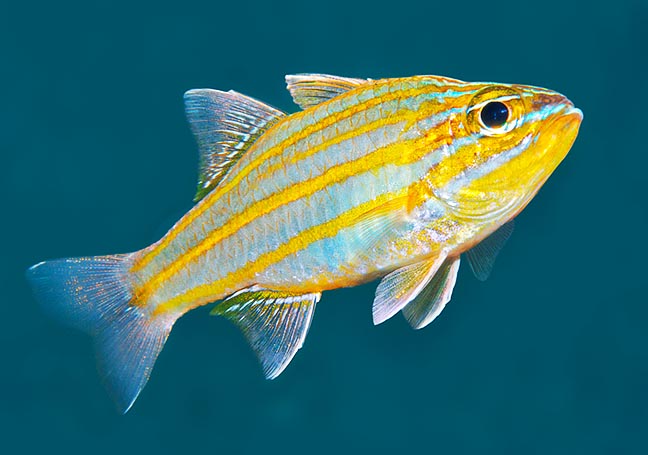Family : Apogonidae

Text © Giuseppe Mazza

English translation by Mario Beltramini
The polychrome Yellowstriped cardinal- fish (Ostorhinchus cyanosoma Bleeker, 1853), known also as Blue-lined Cardinalfish, belongs to the class of Actinopterygii, the fishes with the rayed fins, to the order of Perciformes and to the family of the Apogonidae rich of more than 200 species present in the tropical seas, with some exception like the Apogon imberbis of the Mediterranean or the freshwater species belonging to the genus Glossamia.
The name comes from the Greek “osteon” = bone and “rygcos” = beak, due to the bony jagged jaws placed in an advanced position and replacing the teeth. The name of the species “cyanosoma” comes from the Greek “kyanos” = light blue and “soma” = body, with reference to the background colour of the body.
Zoogeography
It lives in the tropical waters of the Indo-Pacific. Indicatively, we find it from Mozambique and Madagascar up to the Red Sea. Then, at the Maldives, the Cocos Islands, in Australia, Indonesia, New Guinea, Philippines, Taiwan and in the Japanese islands of Ryukyu. Eastwards, it has reached the Solomon Islands, the Vanuatu Islands, the Fijis, the New Caledonia and Tonga.

Infrequent in the aquaria, Ostorhinchus cyanosoma has a very low vulnerability index © Giuseppe Mazza
Ecology-Habitat
It lives in the madreporic formations, in the lagoons, and on the outer side of the reefs, up to 50 m of depth, even if usually it does not go down beyond the 15 m.
Morpho-physiology
The Ostorhinchus cyanosoma can reach the 8 cm, but rarely exceeds the 6 cm and in its whole it recalls the Apogon imberbis and the Ostorhinchus compressus.
On the back, as is usual among the Apogonidae, we note two fins.
The first, triangular, has 7 spiny rays, whilst the second one counts 1 spiny ray and 9 soft rays. The anal fin, almost symmetrical, has 2 spiny rays and 8 soft; the pectoral ones have 14 unarmed rays and the caudal is bilobated.
On the silvery light blue colour of the background, we note 6 yellow-orange horizontal stripes with more intense border, and also the iris and the fins show these decorations.
Ethology-Reproductive Biology
It is a quiet animal living in the shelter of the madrepores or among the long spines of the tropical sea urchins nourishing mainly of small crustaceans and larvae of fishes transported by the currents. The males collect the fecundated eggs and keep them in their mouth until when the hatching occurs. It has reproduced also in captivity, but it is not a frequent fish in the aquaria.
The populations are not affected by the degradation of the reefs caused by the climate changes and may double their number in less than 15 months. The vulnerability index of the species is very low: just 10 on a scale of 100.
Synonyms
Apogon cyanosoma Bleeker, 1853.
→ For general information about FISH please click here.
→ For general information about BONY FISH please click here
→ For general information about CARTILAGINOUS FISH please click here.
→ To appreciate the BIODIVERSITY of BONY FISH please click here.
→ To appreciate the BIODIVERSITY of CARTILAGINOUS FISH please click here.
